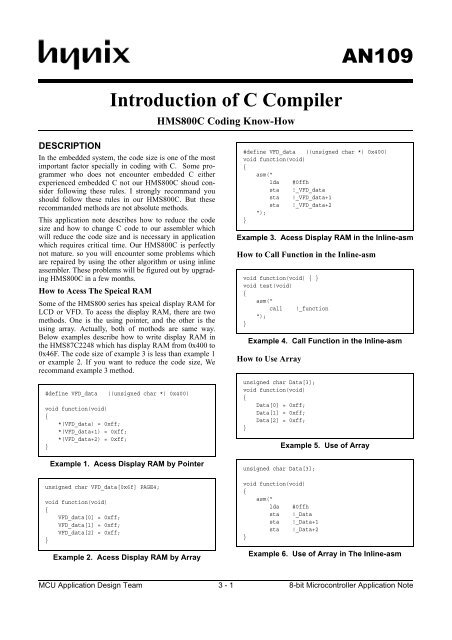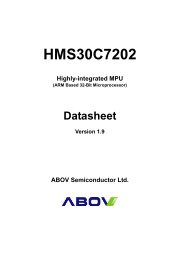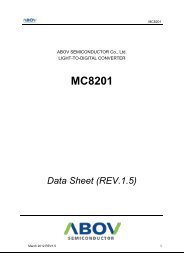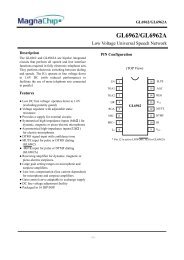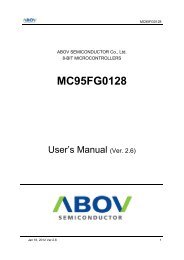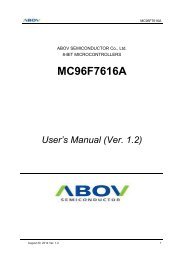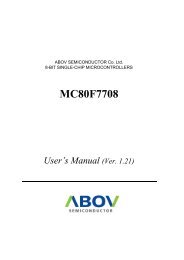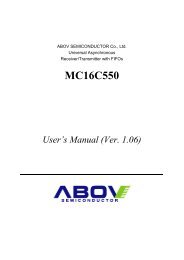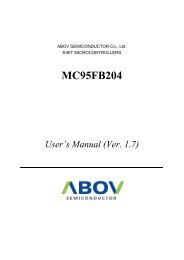You also want an ePaper? Increase the reach of your titles
YUMPU automatically turns print PDFs into web optimized ePapers that Google loves.
<strong>1Introduction</strong> <strong>of</strong> C <strong>Compiler</strong><br />
HMS800C Coding Know-How<br />
<strong>AN109</strong><br />
DESCRIPTION<br />
In the embedded system, the code size is one <strong>of</strong> the most<br />
important factor specially in coding with C. Some programmer<br />
who does not encounter embedded C either<br />
experienced embedded C not our HMS800C shoud consider<br />
following these rules. I strongly recommand you<br />
should follow these rules in our HMS800C. But these<br />
recommanded methods are not absolute methods.<br />
This application note describes how to reduce the code<br />
size and how to change C code to our assembler which<br />
will reduce the code size and is necessary in application<br />
which requires critical time. Our HMS800C is perfectly<br />
not mature. so you will encounter some problems which<br />
are repaired by using the other algorithm or using inline<br />
assembler. These problems will be figured out by upgrading<br />
HMS800C in a few months.<br />
How to Acess The Speical RAM<br />
Some <strong>of</strong> the HMS800 series has speical display RAM for<br />
LCD or VFD. To acess the display RAM, there are two<br />
methods. One is the using pointer, and the other is the<br />
using array. Actually, both <strong>of</strong> mothods are same way.<br />
Below examples describe how to write display RAM in<br />
the HMS87C2248 which has display RAM from 0x400 to<br />
0x46F. The code size <strong>of</strong> example 3 is less than example 1<br />
or example 2. If you want to reduce the code size, We<br />
recommand example 3 method.<br />
#define VFD_data ((unsigned char *) 0x400)<br />
void function(void)<br />
{<br />
*(VFD_data) = 0xff;<br />
*(VFD_data+1) = 0xff;<br />
*(VFD_data+2) = 0xff;<br />
}<br />
Example 1. Acess Display RAM by Pointer<br />
unsigned char VFD_data[0x6f] PAGE4;<br />
void function(void)<br />
{<br />
VFD_data[0] = 0xff;<br />
VFD_data[1] = 0xff;<br />
VFD_data[2] = 0xff;<br />
}<br />
Example 2. Acess Display RAM by Array<br />
#define VFD_data ((unsigned char *) 0x400)<br />
void function(void)<br />
{<br />
asm(“<br />
lda #0ffh<br />
sta !_VFD_data<br />
sta !_VFD_data+1<br />
sta !_VFD_data+2<br />
“);<br />
}<br />
Example 3. Acess Display RAM in the Inline-asm<br />
How to Call Function in the Inline-asm<br />
void function(void) { }<br />
void test(void)<br />
{<br />
asm(“<br />
call !_function<br />
“);<br />
}<br />
Example 4. Call Function in the Inline-asm<br />
How to Use Array<br />
unsigned char Data[3];<br />
void function(void)<br />
{<br />
Data[0] = 0xff;<br />
Data[1] = 0xff;<br />
Data[2] = 0xff;<br />
}<br />
unsigned char Data[3];<br />
void function(void)<br />
{<br />
asm(“<br />
lda #0ffh<br />
sta !_Data<br />
sta !_Data+1<br />
sta !_Data+2<br />
}<br />
Example 5. Use <strong>of</strong> Array<br />
Example 6. Use <strong>of</strong> Array in The Inline-asm<br />
MCU Application Design Team 3 - 1 8-bit Microcontroller Application Note
Introduction <strong>of</strong> C <strong>Compiler</strong><br />
How to Use Struct And Write Struct Data to<br />
ROM Area<br />
Below example 7 discribes how to store struct data in the<br />
ROM and shows how to read struct data in the<br />
function_read(). But the function_write(), which writes<br />
data in the ROM area, is a bad example because<br />
cook_data pointer indicates the ROM area. Example 8<br />
describes struct copy function which copys struct data in<br />
the ROM to struct variable in the RAM. It will be need in<br />
the embedded system which has small RAM size. And<br />
example 9 describes use <strong>of</strong> struct in the inline-asm.<br />
When you use array <strong>of</strong> struct and a variable which indicate<br />
a location <strong>of</strong> array, it will increase the ROM size<br />
remarkablely. So, if you reduce a ROM size, you would<br />
better change C to ASM like example 10. It will reduce a<br />
ROM size dramatically. But if the locational variable <strong>of</strong><br />
array is a constant, ROM size <strong>of</strong> C is as same as one <strong>of</strong><br />
ASM.<br />
typedef struct<br />
{<br />
unsigned char model;<br />
unsigned char power_level[2];<br />
unsigned char disp_data[2];<br />
}cook;<br />
cook RICE[] __attribute__ ((section(".text"))) = {<br />
{1,100,100,4,5},<br />
{2,100,100,3,4},<br />
{3,100,100,2,3}<br />
};<br />
cook *cook_data;<br />
cook data_ram;<br />
unsigned char model, power, disp;<br />
void function_read(void)<br />
{<br />
cook_data = &RICE[1];<br />
model = cook_data->model;<br />
power = cook_data->power_level[0];<br />
disp = cook_data->disp_data[0];<br />
}<br />
// bad example<br />
void function_write(void)<br />
{<br />
cook_data = &RICE[1];<br />
cook_data->model = model;<br />
cook_data->power_level[0] = power;<br />
cook_data->disp_data = disp;<br />
}<br />
Example 7. Use <strong>of</strong> Struct<br />
// struct size : 5bytes<br />
void struct_copy(cook data_ram, cook cook_data)<br />
{<br />
unsigned char i;<br />
for ( i=0 ; i
Introduction <strong>of</strong> C <strong>Compiler</strong><br />
How to Flag change to the Inline-asm<br />
Example 11 decribes how to use a flag in the inline-asm.<br />
The function_C() shows use <strong>of</strong> a flag in the C, and the<br />
function_A() shows use <strong>of</strong> flag in the ASM. If there are a<br />
lot <strong>of</strong> flags, chagne them to the inline-asm. It will reduce<br />
your ROM size remarkablely.<br />
struct flag0<br />
{<br />
char f0:1;<br />
char f1:1;<br />
char f2:1;<br />
char f3:1;<br />
} f;<br />
void function_C(void)<br />
{<br />
f.f0 = 1;<br />
f.f1 = 1;<br />
f.f2 = 1;<br />
f.f3 = 1;<br />
}<br />
void function_A(void)<br />
{<br />
asm(“<br />
set1 _f.0<br />
set1 _f.1<br />
set1 _f.2<br />
set1 _f.3<br />
“);<br />
}<br />
1 if-else or switch-case<br />
2 ~ 19 if-else<br />
20 ~ switch-case<br />
Table 1: Comparison <strong>of</strong> Condition-Statement<br />
Define MICRO with the Inline-asm<br />
Example 12 describes how to use macro with the inlineasm<br />
which has some argurments. The argument must be<br />
gloval variable in the inline-asm. And to acess the variable,<br />
you should attach ‘_’ in front <strong>of</strong> each variable. This<br />
macro multiplies unsigned short type variable ‘A’ by<br />
unsigned char type variable ‘B’. The quotient is stored to<br />
unsigned short type ‘R’ and the remainder is threw away.<br />
#define MUL16_8(A,B,R)<br />
asm("<br />
lda _A+1<br />
ldy _B<br />
mul<br />
sta !_R+1<br />
lda _A<br />
ldy _B<br />
mul<br />
sta !_R<br />
tya<br />
clrc<br />
adc !_R+1<br />
sta !_R+1<br />
");<br />
Example 12. Use <strong>of</strong> Flag in The Inline-asm<br />
Author:<br />
June Choi<br />
MCU Application Team<br />
e-mail: jungmin1.choi@hynix.com<br />
Example 11. Use <strong>of</strong> Flag in The Inline-asm<br />
Comparison Swich-Statement with If-Statemnet<br />
If there are a lot <strong>of</strong> conditions, which condition-statement<br />
is better to reduce the code size. It is depend upon number<br />
<strong>of</strong> condtions. Below the table describes comparison <strong>of</strong><br />
code size as the number <strong>of</strong> conditions.<br />
Number <strong>of</strong> Condition<br />
Better Condtion<br />
Statement<br />
MCU Application Design Team 3 - 3 8-bit Microcontroller Application Note


